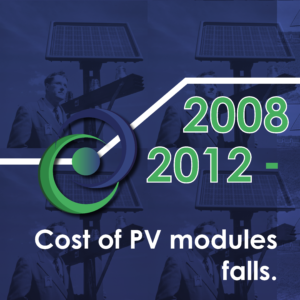Solar Energy
History.
How did it all Started!

Experimenting with metal electrodes and an acidic solution, nineteen-year-old French physicist Alexandre Edmond Becquerel creates the first solar cell, known as a photovoltaic cell, that could carry an electric current from light.
Charles Fritts, an American inventor, creates the first functioning solar panels with solar cells made from selenium wafers. Selenium was discovered to be photovoltaic by Willoughby Smith. The first solar panels were affixed to a New York City rooftop, but these panels are very inefficient with an energy conversion rate of only 1%.
Edward Weston receives the first U.S. patent for “solar cell,” which helps bring more research interest and ultimately creates more efficient solar panels.

Nikola Tesla received the U.S. patent for “method of utilizing, and apparatus for the utilization of, radiant energy” – also known as the solar panel!
Albert Einstein publishes a paper on the theory behind the “photoelectric effect,” which officially proved the process of how the sun creates energy through solar cells.
Robert Millikan performs an experiment on Einstein’s theory on the photoelectric effect, proving the theory.
Einstein wins Nobel Prize for a 1905 paper on the photoelectric effect.

Gerald Pearson, Daryl Chapin, and Calvin Fuller, physicists at Bell Labs, exhibit the first high-power silicon solar PV cell that increases energy conversion efficiency by using silicone instead of selenium wafers.
Interestingly, Bell Labs was a branch of Exxon Mobile but instead of embracing solar, Exxon reverted back to fossil fuels.
Sharp Corporation produces a viable photovoltaic module of silicon solar cells, successfully mass-producing solar panels. Japan installs a 242-watt PV array on a lighthouse, the world’s largest array at that time.
NASA launches the first Nimbus satellite with a 470-watt PV array after the successful launch of Vanguard I by the Naval Research Laboratory.
Research drives PV costs down 80%, allowing for different uses of solar panels to be tested and adopted, mostly for off-grid use.

The University of Delaware creates the first solar-powered building called the “Solar One” which uses PV panels and solar thermal energy.
Kyocera Corp begins production of thin-film silicon ribbon crystal solar modules, simplifying the manufacturing process.
The U.S. Department of Energy establishes the U.S. Solar Energy Research Institute in Golden, CO. This organization is now NREL, the National Renewable Energy Laboratories – they are in charge of renewable energy research for energy independence.
Germany launches a $500M “100,000 Solar Roofs” program. This German subsidy program was pivotal in the development of a viable residential solar industry. The German government spent the money for solar panel adoption to expand at a time when solar panels were still very expensive.
Japan begins “70,000 Solar Roofs” PV subsidy program.
The Energy Policy Act of 2005 (P.L.109-58) creates a 30% investment tax credit (ITC) for commercial and residential solar energy systems that applied from January 1, 2006, through December 31, 2007.
These credits were extended for one additional year in December 2006 by the Tax Relief and Health Care Act of 2006 (P.L.109-432). This helped make solar panels more affordable for both businesses and homeowners.
The California Public Utilities Commission launches the California Solar Initiative (CSI), a 10-year, $3 billion solar subsidy program. After launching, the CSI program is well received by the market, with higher than expected application volume.
Global investment in clean energy exceeds $100 billion, with solar energy as the leading clean energy technology for venture capital and private equity investment. The solar tax credits helped to create unprecedented growth in the U.S. solar industry from 2006-2007.
The Emergency Economic Stabilization Act of 2008 (P.L.110-343) included an eight-year extension of the commercial and residential solar ITC, eliminated the monetary cap for residential solar electric installations, and permitted utilities and companies paying the alternative minimum tax (AMT) to qualify for the credit.
The 30% federal tax credit gets renewed until 2016 – currently reducing each year until it ends in 2024.

The cost of PV modules falls from approximately $5 per watt to $1 per watt, fuelled mainly by continuing strong subsidies in Germany and new subsidy programs in Spain, Italy, and Australia.
Chinese manufacturing companies begin to build large automated solar cell and solar module production factories that further reduce the cost of modules down to $.70 per watt
Residential solar system installations become cost-effective for the average American household. In 2015, more residential solar power is installed in the U.S. in over 18 months than in all the cumulative history prior to this.
The Tesla Motor Company announces its intention to launch a lithium-ion battery storage product at a price point that would make it economic for ordinary American householders to store solar power generated during the day for use at night.
The U.S. Congress passes an eight-year extension to the 30% federal income tax credit, ensuring the continued growth in the adoption of photovoltaic solar power systems in America. The tax credit ends in 2021 but it would be wise for this to be extended, for both solar jobs and for renewable energy.

Now is the best time to save by installing solar panels on your home. The federal tax credit ensures you save on your installation by 30%! Use our free solar calculator to find out the costs, incentives, and returns you would get by installing solar panels.
© 2024 Energetica
